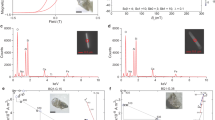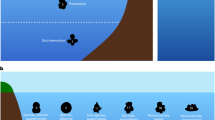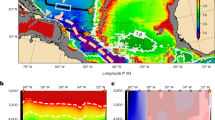Abstract
Massive iceberg discharges from the Northern Hemisphere ice sheets, ‘Heinrich events’, coincided with the coldest periods of the last ice age1. There is widespread evidence for Heinrich events and their profound impact on the climate and circulation of the North Atlantic Ocean, but their influence beyond that region remains uncertain1. Here we use a combination of molecular fingerprints of algal productivity and radioisotope tracers of sedimentation to document eight periods of increased productivity in the subpolar Southern Ocean during the past 70,000 years that occurred within 1,000–2,000 years of a Northern Hemisphere Heinrich event. We discuss possible causes for such a link, including increased supply of iron from upwelling and increased stratification during the growing season, which imply an alteration of the global ocean circulation during Heinrich events. The mechanisms linking North Atlantic iceberg discharges with subantarctic productivity remain unclear at this point. We suggest that understanding how the Southern Ocean was altered during these extreme climate perturbations is critical to understanding the role of the ocean in climate change.
This is a preview of subscription content, access via your institution
Access options
Subscribe to this journal
Receive 51 print issues and online access
$199.00 per year
only $3.90 per issue
Buy this article
- Purchase on Springer Link
- Instant access to full article PDF
Prices may be subject to local taxes which are calculated during checkout

Similar content being viewed by others
References
Hemming, S. R. Heinrich events: massive late Pleistocene detritus layers of the North Atlantic and their global climate imprint. Rev. Geophys. 42, doi:10.1029/2003RG000128 (2004)
Hays, J. D., Imbrie, J. & Shackleton, N. J. Variations in the Earth's orbit: pacemaker of the ice ages. Science 194, 1121–1132 (1976)
van Kreveld, S. et al. Potential links between surging ice sheets, circulation changes, and the Dansgaard–Oeschger cycles in the Irminger Sea, 60–18 kyr. Paleoceanography 15, 425–442 (2000)
Rashid, H., Hesse, R. & Piper, D. J. W. Evidence for an additional Heinrich event between H5 and H6. Paleoceanography 18, 1077, doi:10.1029/2003PA000913 (2003)
Arz, H. W., Pätzold, J. & Wefer, G. Correlated millennial-scale changes in surface hydrography and terrigenous sediment yield inferred from last-glacial marine deposits off northeastern Brazil. Quat. Res. 50, 157–166 (1998)
Little, M. G. et al. Trade wind forcing of upwelling, seasonality, and Heinrich events as a response to sub-Milankovitch climate variability. Paleoceanography 12, 568–576 (1997)
McManus, J. F., Francois, R., Gherardi, J.-M., Keigwin, L. D. & Brown-Leger, S. Collapse and rapid resumption of Atlantic meridional circulation linked to deglacial climate changes. Nature 428, 834–837 (2004)
Rind, D. et al. Effects of meltwater in the GISS coupled atmosphere–ocean model 2. A bipolar seesaw in Atlantic Deep Water production. J. Geophys. Res. 106, 27355–27365 (2001)
Rahmstorf, S. Ocean circulation and climate during the past 120,000 years. Nature 419, 207–214 (2002)
Piotrowski, A. M., Goldstein, S. L., Hemming, S. R. & Fairbanks, R. G. Intensification and variability of ocean thermohaline circulation through the last deglaciation. Earth Planet. Sci. Lett. 225, 205–220 (2004)
Nilsson, J., Brostrom, G. & Walin, G. The thermohaline circulation and vertical mixing: Does weaker density stratification give stronger overturning? J. Phys. Oceanogr. 33, 2781–2795 (2003)
Webb, D. J. & Suginohara, N. Vertical mixing in the ocean. Nature 409, 37 (2001)
Blunier, T. & Brook, E. J. Timing of millennial-scale climate change in Antarctica and Greenland during the last glacial period. Science 291, 109–112 (2001)
Volkman, J. K. et al. Microalgal biomarkers: A review of recent research developments. Org. Geochem. 29, 1163–1179 (1998)
Weaver, P. P. E., Carter, L. & Neil, H. L. Response of surface water masses and circulation to late Quaternary climate change east of New Zealand. Paleoceanography 13, 70–83 (1998)
Pahnke, K., Zahn, R., Elderfield, H. & Schulz, M. 340,000-year centennial-scale marine record of Southern Hemisphere climatic oscillation. Science 301, 948–952 (2003)
Sachs, J. P., Anderson, R. F. & Lehman, S. J. Glacial surface temperatures of the southeast Atlantic Ocean. Science 293, 2077–2079 (2001)
Sachs, J. P. & Anderson, R. F. Fidelity of alkenone paleotemperature reconstructions in southern Cape basin sediment drifts. Paleoceanography 18, 1082, doi:10.1029/2002PA000862 (2003)
Chase, Z., Anderson, R. F. & Fleisher, M. Q. Evidence from authigenic uranium for increased productivity of the glacial Subantarctic Ocean. Paleoceanography 16, 468–478 (2001)
Martin, J. H. Glacial–interglacial CO2 change: the iron hypothesis. Paleoceanography 5, 1–13 (1990)
Boyd, P., LaRoche, J., Gall, M., Frew, R. & McKay, R. M. L. Role of iron, light, and silicate in controlling algal biomass in subantarctic waters SE of New Zealand. J. Geophys. Res. 104, 13395–13408 (1999)
Watson, A. J. & Lefevre, N. The sensitivity of atmospheric CO2 concentrations to input of iron to the oceans. Tellus 51B, 453–460 (1999)
Lefevre, N. & Watson, A. J. Modeling the geochemical cycle of iron in the oceans and its impact on atmospheric CO2 concentrations. Glob. Biogeochem. Cycles 13, 727–736 (1999)
Steig, E. J. et al. Wisconsinan and Holocene climate history from an ice core at Taylor Dome, western Ross Embayment, Antarctica. Geogr. Ann. 82A, 213–235 (2000)
Abbott, M. R., Richman, J. G., Lettelier, R. M. & Bartlett, J. S. The spring bloom in the Antarctic Polar Frontal Zone as observed from a mesoscale array of bio-optical sensors. Deep-Sea Res. II 47, 3285–3314 (2000)
Mitchell, B. G., Brody, E. A., Holm-Hansen, O., McClain, C. & Bishop, J. Light limitation of phytoplankton biomass and macronutrient utilization in the Southern Ocean. Limnol. Oceanogr. 36, 1662–1677 (1991)
Smith, W. O. Jr & Nelson, D. M. Phytoplankton bloom produced by a receding ice edge in the Ross Sea: spatial coherence with the density field. Science 227, 163–167 (1985)
Rohling, E. J., Marsh, R., Wells, N. C., Siddall, M. & Edwards, N. R. Similar meltwater contributions to glacial sea level changes from Antarctic and northern ice sheets. Nature 430, 1016–1021 (2004)
Indermühle, A., Monnin, E., Stauffer, B., Stocker, T. F. & Wahlen, M. Atmospheric CO2 concentration from 60 to 20 kyr BP from the Taylor Dome ice core, Antarctica. Geophys. Res. Lett. 27, 735–738 (2000)
Stoner, J. S., Channell, J. E. T., Hillaire-Marcel, C. & Kissel, C. Geomagnetic paleointensity and environmental record from Labrador Sea core MD95–2024: global marine sediment and ice core chronostratigraphy for the last 110 kyr. Earth Planet. Sci. Lett. 183, 161–177 (2000)
Acknowledgements
Discussions with C. Wunsch, J. Marshall, M. Follows, E. Boyle and P. Parekh contributed to this manuscript. Samples from core MD97-2120 were provided by K. Pahnke and R. Zahn. The Lamont-Doherty Earth Observatory core repository provided samples from core TN057-21-PC2. D. Dryer, M. Fleisher, Y. Chang and M. Bryan assisted with laboratory analyses. Funding for J.P.S. was from the Gary Comer Foundation, the Jeptha H. and Emily V. Wade Award for Research, and a Henry L. and Grace Doherty Professorship. Funding for R.F.A. was from a grants/cooperative agreement from the National Oceanic and Atmospheric Administration.
Author information
Authors and Affiliations
Corresponding author
Ethics declarations
Competing interests
The authors declare that they have no competing financial interests.
Rights and permissions
About this article
Cite this article
Sachs, J., Anderson, R. Increased productivity in the subantarctic ocean during Heinrich events. Nature 434, 1118–1121 (2005). https://doi.org/10.1038/nature03544
Received:
Accepted:
Issue Date:
DOI: https://doi.org/10.1038/nature03544
This article is cited by
-
Millennial atmospheric CO2 changes linked to ocean ventilation modes over past 150,000 years
Nature Geoscience (2023)
-
Centennial-scale changes in the global carbon cycle during the last deglaciation
Nature (2014)
-
Evidence for climatic and oceanographic controls on terrigenous sediment supply to the Indian Ocean sector of the Southern Ocean over the past 63,000 years
Geo-Marine Letters (2012)
-
Upper-ocean-to-atmosphere radiocarbon offsets imply fast deglacial carbon dioxide release
Nature (2010)
-
Molecular evidence for primary producers and sedimentary environmental conditions of Permian Chihsia Formation in Northeast Sichuan, China
Journal of Earth Science (2010)
Comments
By submitting a comment you agree to abide by our Terms and Community Guidelines. If you find something abusive or that does not comply with our terms or guidelines please flag it as inappropriate.



